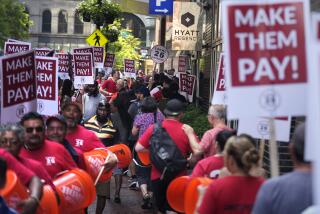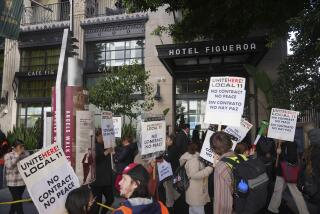Hilton Profit Falls 74% on War-Related Travel Slump
- Share via
Hilton Hotels Corp., a bellwether for the U.S. lodging industry, said Wednesday that the weak economy compounded by fears about traveling during the war cut its first-quarter profit 74%.
All the trends plaguing the industry -- from less spending by businesses on meetings to socialites canceling balls and banquets -- were evident in the details of Hilton’s financial results.
The nation’s third-largest hotel company operates in most segments of the industry. Its brands include everything from New York’s posh Waldorf-Astoria on Park Avenue to the Hampton Inn off Route 99 in Bakersfield to the Hilton Hawaiian Village resort in Waikiki Beach.
Net income at the Beverly Hills-based company fell to $9 million, or 2 cents a share, from $34 million, or 9 cents, a year earlier.
Revenue fell slightly to $917 million from $921 million a year ago. The Hilton network includes more than 2,000 hotels that it either owns, manages or franchises.
Perhaps the only good news for the firm was that Hilton has largely avoided the damage done to the international lodging industry by the outbreak of the pneumonia-like severe acute respiratory syndrome, because its hotels are primarily in the United States.
SARS aside, a report Wednesday from an industry research firm highlighted just how much trouble U.S. hotels are having attracting guests.
Nationwide, hotels have filled just under 59% of their rooms over the last 28 days, according to Smith Travel Research, well below the 65% the industry considers healthy. The latest statistic is near a modern-day low, said J. Cogan, a lodging industry analyst with Banc of America Securities in San Francisco.
“There are still just too many rooms available,” Cogan said. “The potential for this industry to see any meaningful price increases is at least two years away.”
Revenue per available room -- a key financial barometer for hotel companies -- dipped 5.9% to $48.50 compared with a year earlier, according to the Smith report.
The relentless decline has made it difficult for hotel chains to remain profitable, Cogan said.
“Before Sept. 11, there was plenty of fat in the industry and the companies did a good job of eliminating costs without hurting service,” he said. “Now, they are at the point where it is hard to cut more in daily operations, and they are seeing higher health and property insurance and labor costs.”
Although Hilton has escaped the worst effects of some of these trends, it still faces a difficult year, executives said Wednesday during a conference call with investors.
In the first-quarter, occupancy levels at Hilton’s big city hotels were “comparatively solid” but the mix of business has changed. High-paying customers such as business travelers and groups were scarce during the quarter although they were replaced, for the most part, by bargain-seeking vacationers. Indeed, occupancy across all of Hilton’s brands was flat, edging up to 66.8% from 66.5% a year ago.
This resulted in lower room rates as well as food and beverage tabs that were $4 million below the same period last year at hotels owned by the company. Dieter Huckestein, Hilton’s executive vice president, said the decline in food and beverage sales was partially a result of canceled social events in New York, where people are still nervous about possible terrorist attacks.
Hilton’s revenue per available room fell 2.2% in the quarter at properties owned at least a year. And Hilton’s average daily room rate slid 2.7% to $145.82.
The negative trends mostly affected Hilton’s top brands. Revenue per available room at the flagship Hilton hotels fell 3.4%. It fell 3.3% at the Doubletree properties.
Smaller properties in suburban areas and drive-to markets did better. The Hilton Garden Inn chain posted a 2% increase in revenue per available room, reflecting a shift by more people to travel by car.
“Hotels located in the drive-to locations are looking for a reasonably strong summer,” said Huckestein. The company believes California will benefit from this trend.
Nonetheless, Hilton executives were reluctant to predict when the lodging industry would rebound. Hilton said it expects to collect about $3.9 billion in revenue this year, about the same as last year. The lodging chain expects revenue per available room to continue to decline in the 1% to 2% range.
Earnings per share for the year should hit the high 30-cent range, down from the 53 cents posted in 2002, the company said.
Following the announcement, Hilton’s shares rose 24 cents on the New York Stock Exchange to close at $13.24.
More to Read
Inside the business of entertainment
The Wide Shot brings you news, analysis and insights on everything from streaming wars to production — and what it all means for the future.
You may occasionally receive promotional content from the Los Angeles Times.











